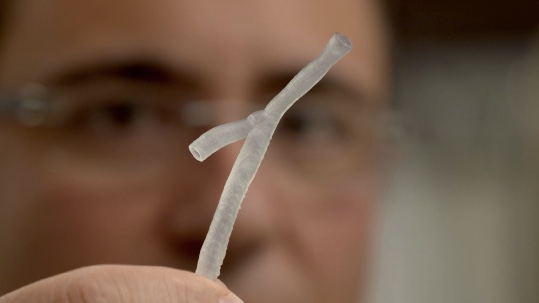 Doctors and engineers at Australia’s University of Melbourne are harnessing the power of supercomputers to create personalized 3-D models from patients with heart disease, from photos taken by a camera thinner than a human hair.
Doctors and engineers at Australia’s University of Melbourne are harnessing the power of supercomputers to create personalized 3-D models from patients with heart disease, from photos taken by a camera thinner than a human hair.
Images collected during routine angiograms are analyzed by a supercomputer, and a model of the patient’s artery is 3-D printed within 24 hours. This process provides cardiologists and researchers with vital information about blood flow behavior and the precise structure of an artery from the inside, helping doctors make better-informed decisions regarding the best sort of stent (a device inserted to hold a collapsed or blocked artery open) for individual patients.
The University of Melbourne researchers’ technique can also be used to detect “hot spots” for buildup of plaque, a waxy substance that accumulates on arterial walls (a condition called atherosclerosis) which contributes to the development of heart disease. Until now, some of these plaque accretions have been difficult to find using traditional techniques.
Potential clinical use of supercomputers in this context of personalized medicine is described in an academic article published last month in the European Heart Journal titled “Biomechanical stress in coronary atherosclerosis: emerging insights from computational modelling,“ co-authored by University of Melbourne Profs. Peter Barlis and Vikas Thondapu, with Christos V. Bourantas, Nicolas Foin, Ik-Kyung Jang, and Patrick W. Serruys.
The researchers said that coronary plaque rupture is the most common cause of blood vessel thrombosis and acute coronary syndrome, so more accurate early detection of plaques prone to rupture may facilitate prospective, preventative treatment.
They observed that conventional diagnostic methods are limited in their capacity to detect these lesions because established imaging features indicating vulnerability don’t confer adequate specificity for predicting symptomatic rupture.
The authors reported that even though experimental and computational studies have underscored the importance of endothelial shear stress in progressive atherosclerosis, the ability of shear stress to predict plaque progression remains incremental.
In their article, researchers examined recent advances in image-based computational modeling that have identified possible mechanisms of plaque progression and rupture, and potentially novel features of plaques most prone to symptomatic rupture, suggesting that with further study and clinical validation, these markers and techniques may improve future culprit plaque detection accuracy and reliability.
Barlis, the study’s lead author, is also an interventional cardiologist with St. Vincent’s and Northern Hospitals in Melbourne.
“Using our ultrasensitive heart scans combined with models derived using supercomputers, we are now able to print out segments of the patients’ arteries and hope to tailor devices to fit them perfectly,” Barlis said in a University of Melbourne release. “No two arteries are shaped the same. We’re all different, with arteries that have different branches and sizes, tapering from larger to smaller. And much like debris accumulates along a riverbank, plaque can cling to certain areas of a person’s artery. So this technology really gives us a clearer picture of those areas.”
 3-D HEART ARTERY: Associate Prof. Peter Barlis examines a 3-D printed heart artery. The ability to model the intricacies of the human heart using 3-D offers cardiologists new insight into heart disease. Photo Credit: The University of Melbourne
3-D HEART ARTERY: Associate Prof. Peter Barlis examines a 3-D printed heart artery. The ability to model the intricacies of the human heart using 3-D offers cardiologists new insight into heart disease. Photo Credit: The University of Melbourne
Identifying plaques that will go on to cause a heart attack remains the holy grail of cardiology. “We ideally want to use models to predict the best type of stent for a patient,” Barlis said. “Once this process is streamlined, we can have a patient on the table and an artery 3-D printed and modeled to guide the procedure. Using a super-high resolution camera, known as optical coherence tomography (OCT), to scan the insides of the heart arteries has made it easier to image cholesterol plaques, but it still isn’t clear which of these plaques will go on to cause heart attacks. If we can identify these high-risk plaques more accurately and much earlier, we may be able to prevent heart attacks before they occur.”
Barlis introduced OCT to Australia in 2009 and has been working at refining the technique to help cardiac patients ever since. OCT is an established medical imaging technique that uses light to capture micrometer-resolution, 3-D images inside biological tissue. He said that 3-D modeling has a promising potential to predict where plaques could form, and will ultimately help cardiologists predict heart attacks.
The study’s co-author and University of Melbourne researcher, Vikas Thondapu, said clues about dangerous cholesterol plaques lie in certain disturbances in blood flow patterns. “Our work involves using supercomputers to simulate blood flow in the arteries. The goal is to use blood flow patterns and disturbances to potentially predict the future development of high-risk plaques,” Thondapu said.
Barlis and his research team at the University of Melbourne now have two ARC grants to work with the university’s Engineering School to find a biocompatible polymer for 3-D printing of heart stents that will precisely match someone’s physical characteristics, reducing stent collapse and risk of complications. The researchers are also interested in developing new, biodegradable polymers that will allow a 3-D printed stent to slowly disintegrate over time, and that can deliver drugs directly to the plaque at its location.
The Imperial College in London and Harvard University in Cambridge, Mass., are collaborating with the University of Melbourne on this research project.

